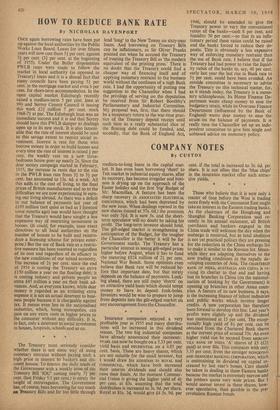HOW TO REDUCE BANK RATE
By NICHOLAS DAVENPORT
ONCE again borrowing rates have been put up against the local authorities by the Public Works Loan Board. Loans for over fifteen years will now cost them 51 per cent. against 53 per cent. (3 per cent. at the beginning of 1955). Under the Butler dispensation PWLB rates were made to follow the market in local authority (as opposed to Treasury) loans and it is a dismal fact that many councils have been paying 54 per cent. in the mortgage market and even 6 per cent. for short-term accommodation. In the open capital market Edinburgh recently raised a medium-term 5 per cent. loan at 99-1 and Surrey County Council is issuing this week £21 million 5 per cent. stock 1968-71 at par. The Edinburgh loan was an immediate success and it is sad that Surrey should have this PWLB damper as dealings open up in its new stock. It is also lament- able that the rate of interest should be used to this savage extent to restrict social in- vestment. Interest is rent for those who borrow money in order to build houses and every time the rate of interest is raised -+ per cent, the weekly rent on a new three- bedroom house goes up nearly 2s. Since the dear money campaign started in February, 1955, the increase in rents due to the rise in the PWLB loan rate from 31 to 51 per cent. has amounted to 13s. 4d. a week. All this adds. to the cost of living, to the final prices of British manufactures and so to the difficulties we are now experiencing in earn- ing our living abroad. As there was a deficit in our balance of payments last year of £103 million (not quite as bad as I forecast some months ago) one would have thought that the Treasury would have sought a less expensive way of restricting investment in houses. (It could, for example, issue exact directives to all local authorities on the number of houses to be built and reintro- duce a licensing scheme for private enter- prise.) But the use of Bank rate as a restric- tive measure has been resorted to regardless of its cost and regardless of its efficacy in the new conditions of our mixed economy. The increase of 21 per cent. since the end of 1954 is costing the Treasury an extra £150 million a year on the floating debt; it is costing industry and private people an extra £45 million a year on their bank ad- vances. And, as everyone knows, while dear money is regarded as an irritating extra expense it is not an actual deterrent to busi- ness people because it is chargeable against tax. It means even less to the nationalised industries, which, being monopolies, can pass on any extra costs in higher prices to the consumer without any difficulty. It is, in fact, only a deterrent to social investment in houses, hospitals, schools and so on.
The Treasury must seriously consider whether there is not some way of using monetary restraint without paying such a high price in interest to bankers and dis- count houses. To finance the daily needs of the Government with a weekly issue of the Treasury Bill 'IOU' costing nearly 51 per cent. (last Friday 5.1 per cent.) is surely the height of extravagance. The Government has, of course, been borrowing far too much pa Treasury Bills and far too little through
lend 'long' to the New Towns on sixty-year loans. And borrowing on Treasury Bills can be inflationary, as Sir Oliver Franks pointed out when he accused the Treasury of treating the Treasury Bill as 'the modern equivalent of the printing press.' There is no doubt that the Treasury could find a cheaper way of financing itself and of applying monetary restraint to the business world without the costliness of a high Bank rate. I had the opportunity of putting one suggestion to the Chancellor when I had the privilege of serving on the deputation he received from Sir Robert Boothby's Parliamentary and Industrial Committee. My proposal was, first, that there should be a temporary return to the war-time prac- tice of the Treasury deposit receipt until such time as a really substantial slice of the floating debt could be funded, and, secondly, that the Bank of England Act,
1946, should be amended to give the Treasury power to vary the conventional ratios of the banks—cash 8 per cent. and liquidity 30 per cent —so that In an infla- tionary period these ratios could be raised and the banks forced to reduce their de- posits. This is obviously a less expensive way of enforcing monetary restraint than the use of Bank rate. I believe that if the Treasury had had power to raise the liquid- ity ratios of the banks to, say, 40 per cent. early last year the last rise in Bank rate to 51 per cent. could have been avoided. An outside committee is necessary to advise the. Treasury on this technical matter, for, as it stands today, the Treasury is a mone- tary schizophrenic. Its Home Finance De- partment wants cheap money to ease the budgetary strain, while its Overseas Finance Department (influenced by the Bank of England) wants dear money to ease the strain on the balance of payments. It is really time the Chancellor set up an inde- pendent committee to give him single and unbiased advice on monetary policy.


































 Previous page
Previous page